Harrogate (Stonefall) Cemetery
Stonefall Cemetery was begun in 1914 but the vast majority of the burials here are of airmen who died during the Second World War when bomber command bases were established across Yorkshire. Today, NEarly 1,000 service men and women lie at rest in the beautiful war graves plot within the War cemetery.
![]()
Although far from the fighting fronts during both World Wars, Harrogate was nevertheless a hub of military activity. During the First World War hundreds of local people volunteered to serve and many saw action overseas. Some of those who were wounded in battle were returned to Great Britain to be cared for, perhaps near home in one of the military or Red Cross hospitals based in the town. During the Second World War Harrogate’s men and women once again volunteered to serve overseas, but the town itself became an important administration, training, medical and logistics base. For much of the war 4 and 6 Groups of Bomber Commander were based in Yorkshire and many of the 1,000 servicemen and women buried in Stonefall today served with these formations. Over 660 belonged to the Royal Canadian Air Force, but there are Australian, New Zealand and British personnel here too, along with three Soviet soldiers and a German.
Find out more
For regular visitors to the Western Front in France and Belgium, Harrogate (Stonefall) Cemetery will feel very familiar. Visitors here will find ordered rows of Portland headstones, stunningly maintained horticulture, and features like the Cross of Sacrifice and Stone of Remembrance.
Located south-east of Harrogate, on the outskirts of the town, just off the A661 on Forest Lane, Harrogate (Stonefall) Cemetery is a must visit for those in the area.
Although far from the fighting fronts during both World Wars, Harrogate was nevertheless a hub of military activity. During the First World War hundreds of local people volunteered to serve and many saw action overseas. Those who were wounded in battle often returned home to be cared for in one of the military or red cross hospitals based in the town.
Stonefall Cemetery was opened by the local authorities in 1914, but during the First World War only 16 service personnel were buried here, with a further 7 commemorated by special memorials. Their graves can be found scattered throughout the civilian part of the cemetery. Other First World War service personnel we laid to rest in local churchyards and cemeteries across Harrogate, including at Harlow Hill and Grove Road.
During the Second World War Harrogate’s men and women once again volunteered to serve overseas, but the town itself soon became an important administration, training, medical and logistics base. Throughout the war No. 7 Personnel Reception Centre was based in Harrogate and many of the large hotels in the centre of town were requisitioned for RAF staff. Harrogate was also briefly home to the Women’s Auxiliary Air Force Training Centre and columns of newly recruited WAAFs marching through town were a common sight.
Upon the outbreak of the Second World War, the cemetery authorities had set aside a small plot in Harrogate Stonefall Cemetery near the crematorium in Sections 20E and 21E, for military burials but as the war went on more space was required.
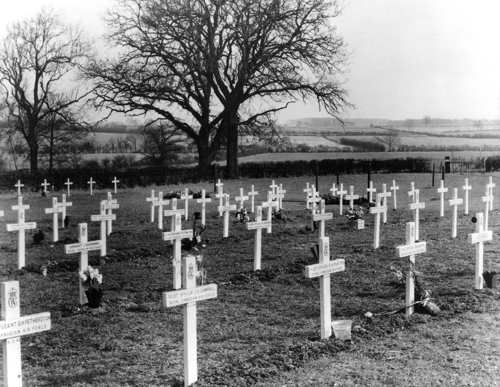
War Graves Commission wooden crosses mark the graves in Harrogate (Stonefall) Cemetery immediately after the Second World War. In time these would be replaced by the stone markers you can see today © CWGC
By 1942 two Bomber Groups were based across Yorkshire. No. 4 Group was based at airfields to the south and east of York, and for much of the war their headquarters were at Heslington Hall on the outskirts of York. No. 6 Group of the Royal Canadian Air Force was located to the north of York, with their headquarters at Allerton Park near Knaresborough, which the Canadians nicknamed ‘Castle Dismal’. Between them, 4 and 6 Groups flew more than 102,000 sorties from Yorkshire and lost over 2,200 aircraft on operations.
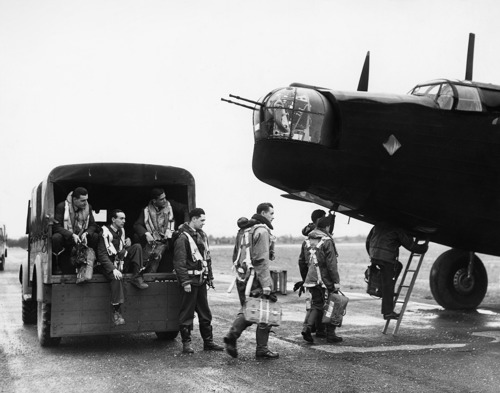
Aircrew of No. 405 (Vancouver) Squadron RCAF board their Wellington Mk II at Pocklington, July 1941 © IWM HU 108387
The squadrons of 4 and 6 Groups suffered heavy losses throughout the war. Many aircraft were shot down, but others limped home with badly wounded crew aboard. These injured airmen were cared for in hospitals across Yorkshire, including in the military wing of Harrogate General Hospital. In 1943, with casualties increasing, the decision was taken to create a much larger air forces section in Stonefall Cemetery.
By the end of the Second World War, more than 950 service personnel had been laid to rest in the air forces section, many of them far from their homes in Canada, Australia, New Zealand, and other parts of the Empire. Over two thirds of those buried or commemorated here were members of the Royal Canadian Air Force who served with 4 Group squadrons.
In addition, there are some 97 men of the Royal Australian Air Force and 23 of the Royal New Zealand Air Force resting here, and one leading aircraftswoman of the Women’s Auxiliary Air Force. Also within the cemetery are 35 army and navy dead, among them three women of the Auxiliary Territorial Service and a Territorial Army nurse, three Soviet soldiers and one German.
After the war, the Ontario Horticultural Association presented the Commission with the Canadian maple trees planted here in the war graves plot.
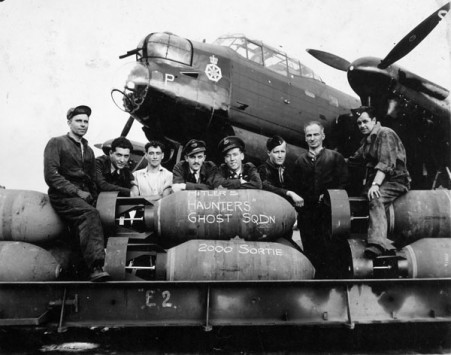
Ground- and air-crew of No. 428 (Ghost) Squadron, RCAF, with their Lancaster “P-Peter” which flew the squadron’s 2000th sortie, RAF Middleton St. George, August 1944. Department of National Defence collection, Library and Archives Canada, e005176190
While Harrogate (Stonefall) Cemetery contains burials from both World Wars, the vast majority are for airmen killed during the Second World War. The cemetery, like several others around the UK, was chosen as the location for an RAF regional cemetery for use by the RAF during the war. In this case, its location was chosen not only because of its central position in the country, which would allow casualties from various regions to be brought to it for burial, but also because it was felt that its pleasant surroundings which would be of great comfort to visiting families.
This plan, from July 1943, shows the proposed layout of the cemetery, prior to any architectural treatment having been undertaken by the Commission.

Large numbers of burials took place in the cemetery during the war. At one point, burials were averaging between 30-40 per week, indicative of the high toll the war was taking on air force personnel, killed in training accidents or crashing during or on return from military operations. This steady stream of burials placed considerable strain on the local cemetery superintendent, who at times did not have enough labour available to carry out any of the additional maintenance work required. As a result, various attempts were made to provide extra manpower for use in the cemetery. This included a group of 8 German PoWs who were sent from the nearby camp at Ripon to assist with the digging of graves and general maintenance duties at the cemetery, but this proved a contentious decision for one relative who visited the cemetery in 1944 and complained about their presence
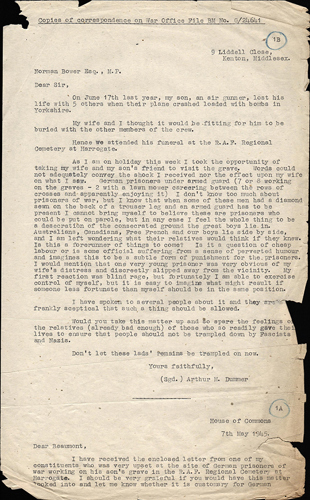
“I feel the whole thing to be a desecration of the consecrated ground the great boys lie in. Australians, Canadians, Free French and our boys lie side by side and I am left wondering what their relatives would think if they knew…..Don’t let these lads’ remains be trampled on now”
Both the Commission and the War Office, while sympathetic to the feelings of the relative, noted that this had been the only complaint received about the issue, and pointed out that German POWs were being used extensively by Grave Units overseas in areas where it would be impossible to carry out the necessary work without them.
Two thirds of the airmen buried in the cemetery are Canadian. As a result, it was decided that the horticultural treatment of the site would reflect this large Canadian presence by incorporating maple trees into the planting schemes, as this letter from the architect Sir Edward Maufe shows.

The maple trees themselves had been donated by the Ontario Horticultural Association, who delivered them to Brookwood Military Cemetery. From here they were sent on to Harrogate by train, their transport arranged by the Commission’s Head Gardener at Brookwood, Mr. T.H. Opie. For many years Opie had worked for the Commission as a gardener in France but had been forced to evacuate in May 1940 when German forces invaded, and once back in the UK was put to work in Brookwood.

The design for the cemetery includes an RAF shelter, inscribed with the RAF motto ‘PER ARDUA AD ASTRA’, a Latin phrase meaning ‘through adversity to the stars’.
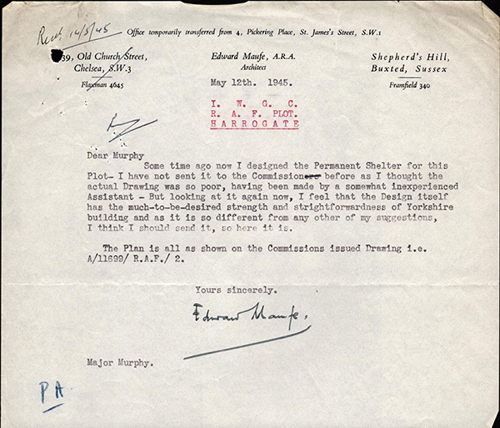
Shelter buildings like this one were constructed in a number of RAF regional cemeteries, but Maufe, the architect, tried to treat each shelter individually and in sympathy to its location. In this letter Maufe comments that his design “has the much-to-be-desired strength and str[a]ightforwardness of Yorkshire building”, and it is clear that the local building style greatly influenced the final shelter construction.

Despite the obvious care and attention paid by Maufe and other Commission architects in the design of the cemeteries, and the efforts by the Commission and its staff to provide permanent places of rest which did justice to the sacrifice of those buried and commemorated in them, for many families this could not replace their desire to have their loved ones buried closer to home.
Just as had occurred after the end of the First World War, many relatives of the fallen sought to overturn the ban on the repatriation of the war dead. In the case of Flight Sergeant William Ritchie Ingram, of the Royal New Zealand Airforce, his parents, Duncan and Elizabeth, made repeated requests to be allowed to exhume his remains from Harrogate in order that he could be cremated and his ashes sent back to New Zealand.
One heart-breaking letter to the Commission from William’s father, written in March 1945, sums up their intense feeling on the matter:
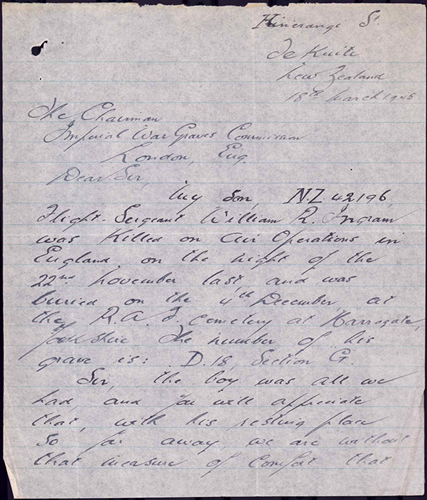
‘Sir, the boy was all we had, and you will appreciate that, with his resting place so far away we are without that increase of comfort that would come from the personal care of his grave. My wife is broken-hearted, and has only been sustained by my promise that I would do everything possible in an endeavour to have the boys remains brought home to New Zealand”.
Tactfully, and with great sympathy, the Commission could only write back to say that it was not possible to accede to the request, but that they should rest assured that William’s grave would be permanently cared for in Harrogate.
In March 1946, William’s parents travelled to Harrogate and again intimated their desire to have his body returned to New Zealand. During their stay, and sensing that they might not be able to overturn the decision, they enquired about purchasing a house in Harrogate so as to be near their son’s grave, but returned to New Zealand, without William, in January 1947.
In a final letter to the Commission, Elizabeth signed off with this pointed remark
“It's rather a pity we have no mothers on the Commission, perhaps they would be more human”
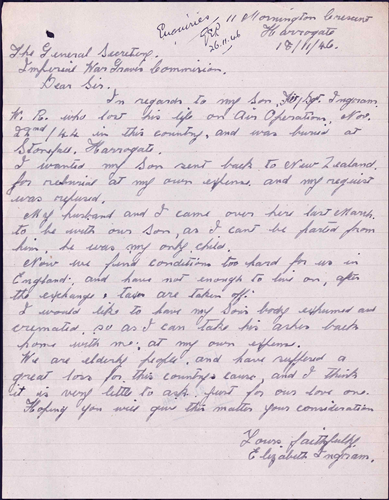
However, this is not the end of the story, for in 1966 an article appeared The People newspaper, concerning an elderly New Zealand couple living in Harrogate. 12 years earlier, in 1954, Duncan and Elizabeth had sold up their home and moved to Harrogate for good. The article went on to say that “hardly a day has passed without one or the other of them visiting Bill Ingram’s grave”. In the end, their wish not to be parted from their son was realised.
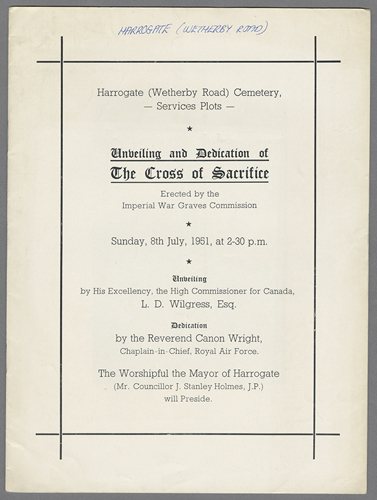
The completed cemetery was unveiled on Sunday 8th July 1951. In reference to high numbers of Canadian casualties buried in the cemetery, the Cross of Sacrifice was unveiled by the High Commissioner for Canada Leolyn Dana Wilgress, with the dedication being performed by Reverend Canon Wright, the Chaplain-in-Chief of the Royal Air Force.
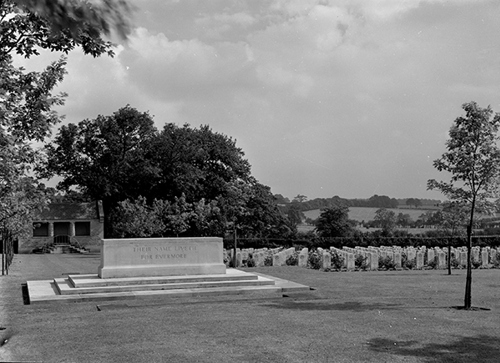
Visit Harrogate (Stonefall) Cemetery
Harrogate (Stonefall) Cemetery is located south-east of Harrogate, on the edge of the town, just off the A661 on Forest Lane. Before visiting we recommend you consult:
Visit the website of the Site Authority
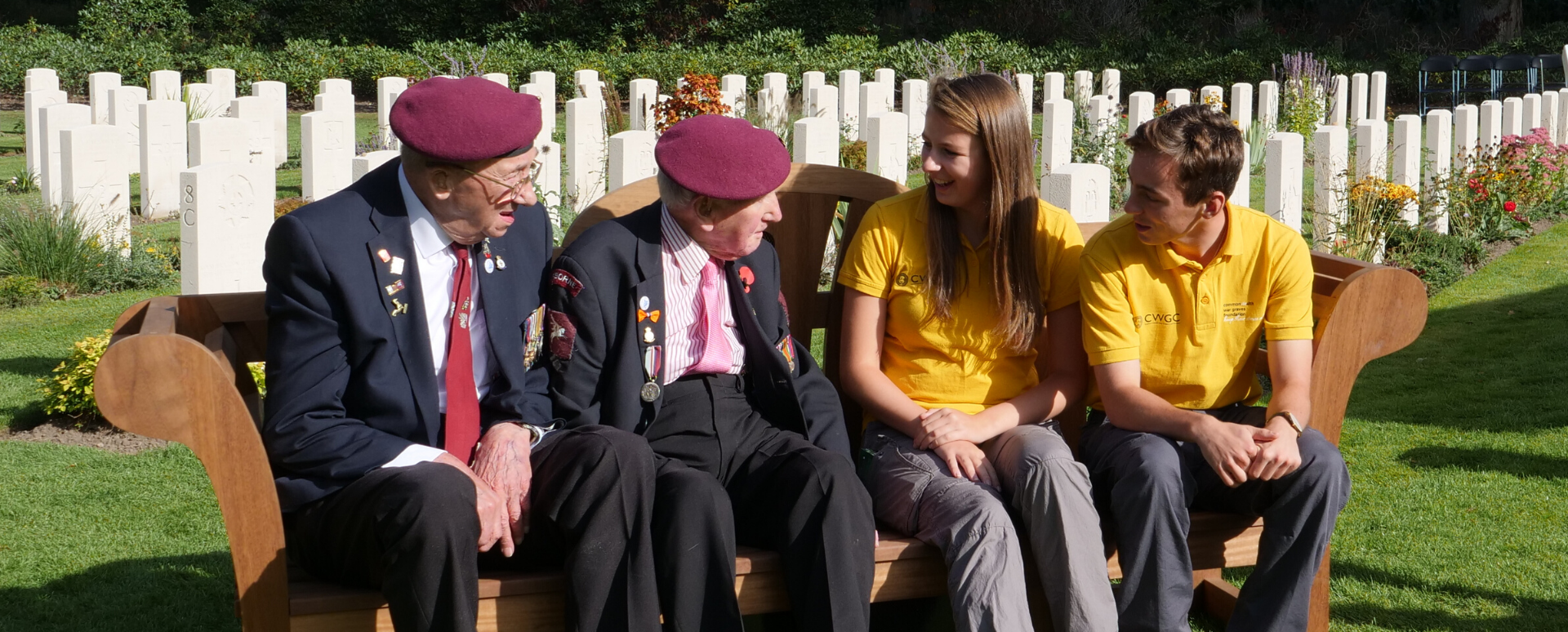
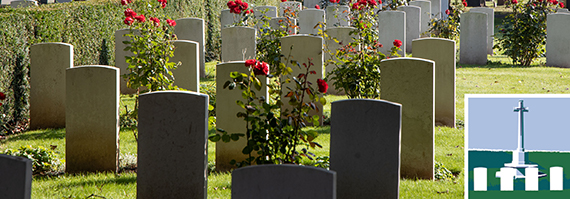
Hull (Northern) Cemetery is the final resting place of over 400 world war servicemen and women. Many of those buried here were laid to rest by their families.
Hull Northern Cemetery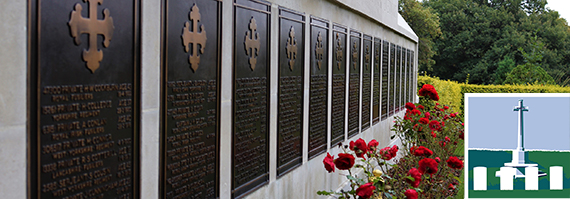
Over 320 Commonwealth servicemen and women of two world wars are commemorated here. Many died of wounds at the 2nd Northern General Hospital, one of the largest hospitals in the north of England.
Leeds (Lawnswood) Cemetery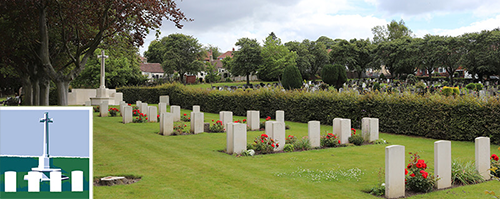
Buried or commemorated at Newcastle-Upon-Tyne (West Road) Cemetery & Crematorium are nearly 200 Commonwealth servicemen and women of the Second World War.
Newcastle-Upon-Tyne (West Road) Cemetery
The former Scarborough Cemetery was established in the 19th century. Today Scarborough (Manor Road) Cemetery and the neighbouring Scarborough (Dean Road) Cemetery contain some 54,000 civilian burials.
Scarborough (Manor Road) Cemetery



